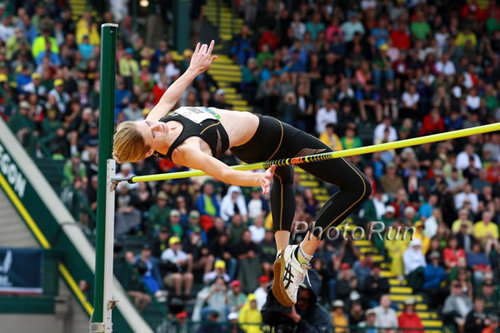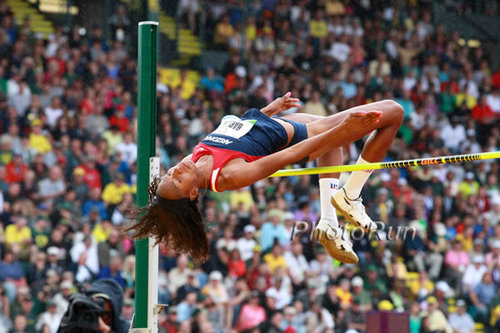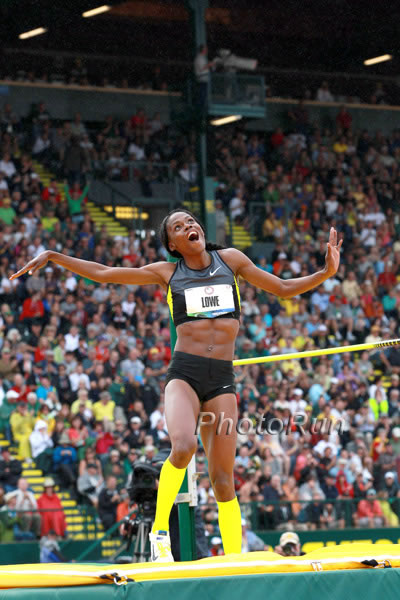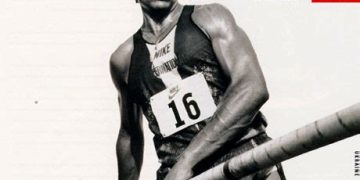 Amy Acuff, 2012 US Oly High Jump, photo by PhotoRun.net
Amy Acuff, 2012 US Oly High Jump, photo by PhotoRun.net
Right On Track

By Dave Hunter
July 31, 2012
A large measure of the enjoyment of an approaching Olympic Games – indeed any highly-awaited sporting event – is the speculation about the athletes, their expected performances, and the anticipated event outcomes. The London Olympiad is no different. And while this building excitement reaches across all Olympic sports, there is, to be sure, no shortage of enthusiasm or conjecture surrounding the running, the jumping, and the throwing that will begin this Friday in London’s Olympic Stadium.
Athletics – to use the old-school vernacular – is, of course, comprised of track events and field events. Last week, the focus was on selected, lingering questions surrounding United States’ athletes competing on the track. This week, the light will shine on a half dozen unanswered inquiries related to American field performers competing in the field events.
1. Will the USA women be poised performers in the competitive high jump?
The US is sending a curious trio of women high jumpers to the Olympic Games. The threesome represents, in essence, the evolutionary career-span of an athlete: the talented, emerging heir apparent [Brigetta Barrett]; the dominant athlete in her prime [Chaunte Lowe]; and the comebacking legend [Amy Acuff].
Can one member – or perhaps more than one – of this trio produce the type of poised performance that can win a medal? A scan of the world competitors suggests that podium positions could be garnered by one or more of America’s lady high jumpers. Only one athlete [Russia’s Anna Chickerova – with jumps of 2.02m [6’7½”] and 2.03m [6’7¾”] has leaped higher than the 2.01 [6’7″] clearances made by Barrett and Lowe this year. With Tia Hallebaut, the upset gold medalist at the Beijing Games, under-performing this year and the always-popular Blanka Vlasic sidelined by injury, the opportunity is there for unexpected medalists in this event.
Lowe, with substantial international experience, is the quintessential cool competitor and is most likely to perform at her best in London’s massive Olympic Stadium. Her OT performance demonstrated that she has come all the way back from the maternity leave that limited her competitions and performances in 2011. Barrett is an enormous talent with what many believe is yet-untapped upside potential. But she will need to show that her nearly-nonexistent international experience will not limit her performance on the Olympic stage. Acuff solidified her legacy as a high-jumping icon by coming out of retirement to post the “A” standard and then make her 5th Olympic team. As an Olympic veteran, Acuff will undoubtedly turn in an unflappable performance in London. But her 2012 best clearance of 1.95 [6’4¾”] suggests that an Olympic medal is likely out of reach for her this time.
2. Will High Jumper Jesse Williams produce an Olympic performance worthy of the world champion that he is?
Last year, American high jumper Jesse Williams won the USA outdoor national championship with a PR leap of 2.37m [7’9¼”] – a height that proved to be the world’s highest clearance in 2011. Williams carried that momentum on to Daegu where he jumped 2.35m [7’8½”] to win the world championship gold medal. By the end of 2011, Williams had won the Samsung Diamond league title and was named the Jesse Owens Male Athlete of the Year by USATF. Williams had the table set perfectly as the Olympic year began.
But the pathway to London has not been without challenges for the reigning world champion. Earlier this year, Williams captured the USATF indoor title and, in June, he notched a high jump win at the New York Adidas Grand Prix Diamond League meeting with an impressive meet-record clearance of 2.36m [7’8¾”]. But the world champion dodged a bullet at the Olympic Trials. Williams was relegated to fourth place in the high jump final when Nick Ross cleared 2.28 on his first attempt. But Williams’ fourth place finish was just good enough to send him to London since Ross lacked the all-important “A” standard leap [2.31] necessary to make the team.
To keep things in perspective, it must be remembered that only two other athletes year have made higher clearances this year than Williams’ New York jump of 2.36m [7’8¾”]. The Russian duo of Ivan Ukhov [2.39m] [7’10”] and Andrey Silnov [2.37] [7’9¼”] will be definite medal contenders in London. The possibility of a throw-back Olympic high jump battle between American and Russian athletes evokes memories of the fierce high jump competitions of the 1960’s between John Thomas and Valeriy Brumel and suggests that the men’s high jump competition will provide great theater on the Olympic stage.
But can Williams bring his “A” game to the London competition? There is some evidence that Williams’ near-disaster in Eugene may have proved to be just the wake-up call he needed. Last week in Monaco, the world champion appeared to be back on track as he rang up a much-needed, confidence-building victory with a winning jump of 2.33 [7’7½”] .
Jesse Williams knows what he needs to do. And he has shown he has the proven ability to do it. Now he has to put it all together when it counts – at the 30th Olympiad.
3. Can Jill Camarena-Williams or Michelle Carter summon up the career-defining throw that will earn an Olympic medal?
A look-back into the annals of track and field would reveal many documented occasions when two closely-matched performers in the same event have unwittingly inspired each other to reach their respective potentials through spirited competitions that served to bring out the best in both. Think about it: Ryun and Liquori; Coe and Ovett; Gebresaillasse and Tergat; Eaton and Hardee – the list could go on and on. We can currently witness that phenomenon at work with American shot put performers Jill Camarena-Williams and Michelle Carter. In recent years, each has pushed and inspired the other to practice with focus and compete with intensity.
How might this competitive duo fare at the London Games? The competition promises to be tough and deep. While multiple-time national champion Camarena-Williams’ current season – highlighted by her OT victory in the shot – is on a wonderful trajectory toward the Games, her 2012 best heave of 19.82m [65’¼”] places her behind the 2012 bests of 4 other competitors. But it’s all about doing it in the Olympics. Camarena-Williams’ bronze medal-winning performance in the 2011 world championships shows that she can produce at the pressure-packed championship venues. She just needs to find that career-defining throw – that big bomb – that can get her on the podium. The task may be more daunting for Carter. Eleven different athletes have thrown farther than Carter’s seasonal best of 19.32m [63’4½”].
With 4 competitors having thrown over 20m – two of whom have thrown over 21m [Belarus’ Nadzeva Ostapchuk at 21.58 [70’9½”] and New Zealand’s Valerie Adams at 21.11 [69’3″] – the chances for an American medal in this event are narrow, but not non-existent. Remember, it only takes that one big throw…
4. Could Hoffa, Whiting, and Cantwell perform the unspeakable accomplishment that wasn’t achieved in 2008?
Track and field might be better off if it became a little more superstitious lik
e other sports – where premature conjecture about anticipated performance is considered a jinxing practice. During the last Olympic year, more than a few knowledgeable track and field fans began crowing – prematurely, it turned out – about the likelihood that the U.S. men would “Sweep” the Beijing medals in the shot put. There has been little or no talk of a “Sweep” at this Olympiad – although the prospects of shot put dominance by the U.S. men seem no less compelling this time around.
Heading into the Games, the members of the US men’s shot put trio – Christian Cantwell [22.31m / 73’2¼” ]; Reese Hoffa [22.00m / 72’2″]; and Ryan Whiting [21.66m / 71’¾” ] – have seasonal best heaves longer than any of their foreign competitors. But a quartet of non-American shot putters – led by Poland’s Tomasz Majewski [21.60m / 70’10¼”] and Germany’s David Storl [21.58m / 70’9½”] – is ready to pounce if any of the American’s would falter when it counts.
The three Americans have done more than just compile impressive pre-Olympic performances. They are hungry for London success and they know what they have to do.
Following his Trials victory, Hoffa acknowledged that London would be his final Games – and his last chance to secure an Olympic medal. In assessing his prospects, Hoffa candidly offered, “It is more about taking care of my body from here, going into the competition feeling good. I know I have to be more aggressive and just go for it.”
Cantwell, with the year’s longest throw which he posted in the weeks leading up to the Games, knows what it takes to capture an Olympic medal. He took the silver in Beijing 4 years ago. And he won the world championship in the shot in 2009 in Berlin. With his early-season maladies apparently now behind him, Cantwell seems to be poised for a pinnacle performance in London.
Whiting, the new-comer of the group, excelled under pressure in Eugene and blocked frenzied shot veteran Adam Nelson from another Olympic appearance. At 25, the recent Arizona State graduate is still perfecting the subtleties of the craft. And although Whiting lacks extensive international experience, his winning performance at the 2012 indoor world championships should help him stay composed and focused in the ring in London.
So, like baseball and other sports, let’s be superstitious. Gentlemen, we promise to refrain from using the “S” word in discussing anticipated Olympic shot put outcomes in the hopes that you three will perform at the top of your game in London.
5. Can the USA’s upstart triple jump duo hold off the world?
It’s a long way from the humid climes of Gainesville, Florida to London’s Olympic Stadium. But that is the pathway that has been followed by Christian Taylor and Will Claye, America’s two premier triple jumpers. With Olympic athletics prepared to get underway within days, the former Florida Gator teammates Taylor [17.63m / 57’10”] and Claye [17.55m / 57’6¾”] are the world’s two top 2012 triple jump performers. While pre-Olympic marks are of no value once the Games begin, there is supporting evidence to suggest that the American duo is well prepared to post top flight marks on the London runway. Both athletes are healthy and their progressive performances leading up to London are hopeful signs for special Olympic performances by these two young athletes.
But a handful of foreign Olympic competitors will be nipping at the Americans’ heels. Russia’s Lyukman Adams [17.53m / 57’6″] and Italy’s Fabrizio Donato [17.52m / 57’5¾”] head a small group of non-American triple jumpers who could earn a spot on the medal stand. Also, a sizeable home-field advantage will undoubtedly be provided to the defending Olympic champion Phillip Idowu – a Brit. While the reigning gold-medalist has yet to pop a truly impressive jump this year, the British roar within the Olympic Stadium might be just the inspiration Idowu needs to summon up a magical Olympic moment.
6. Who will be the USA’s unexpected Olympic field medalist?
The joy that surrounds the unexpected Olympic medalist is always a highlighted moment of the Games. The United States track and field contingent always seems to produce at least one at every Olympiad. Who will be the field athlete to surprise this year?
Might it be Marquise Goodwin in the long jump? Over the years, it has been increasingly difficult for college track and field athletes – burdened by the rigors of the lengthy collegiate seasons – to even make the USA Olympic team, much less earn at medal at the Games. And while it is true that the resilient Goodwin has posted some of the top long jump marks this year, an Olympic medal for this Texas Longhorn would be an unexpected – and joyful – capstone to an impressive season.
How about Brigetta Barrett in the high jump? All eyes will be on prime-time performer Chaunte Lowe, Queen of the High jump. But Barrett displayed uncommon composure in Eugene to match Lowe jump for jump and earn her trip to London. If Barrett can handle the bright lights of London’s big stage and jump to her capability, we just might see her on the medal stand.
Could Erik Kynard, another collegian, step up in the high jump? There is something about Kynard’s swagger, his Stonesian high jump confidence, that suggests that he might not only survive the Olympic pressure cooker – he may well thrive in the Games’ spotlight. With only Jesse Williams and 4 foreign athletes with higher 2012 clearances, a medal winning performance by Kynard is a distinct possibility. And wouldn’t we like to see Kynard replace that silly Burger King crown he wore after his NCAA win earlier this year with an infinitely more tasteful – and unexpected – Olympic medal?
~Dave Hunter























